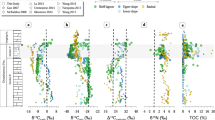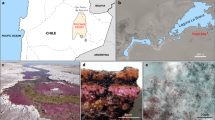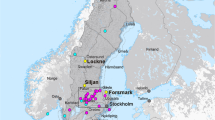Abstract
The colonization of emergent continental landmass by microbial life was an evolutionary step of paramount importance in Earth history. Here we report direct fossil evidence for life on land 3,220 million years ago (Ma) in the form of terrestrial microbial mats draping fluvial conglomerates and gravelly sandstones of the Moodies Group, South Africa. Combined field, petrographic, carbon isotope and Raman spectroscopic analyses confirm the synsedimentary origin and biogenicity of these unique fossil mats as well as their fluvial habitat. The carbon isotope compositions of organic matter (δ13Corg) from these mats define a narrow range centred on −21‰, in contrast to fossil mats of marine origin from nearby tidal deposits that show δ13Corg values as low as −34‰. Bulk nitrogen isotope compositions (2 < δ15N < 5‰) are also significantly different from their marine counterparts (0 < δ15N < 3‰), which we interpret as reflecting denitrification in the terrestrial habitat, possibly of an atmospheric source of nitrate. Our results support the antiquity of a thriving terrestrial biosphere during the Palaeoarchaean and suggest that a complex and microbially driven redox landscape existed during the deposition of the Moodies Group, with distinct biogeochemical cycling occurring on land by 3,220 Ma.
This is a preview of subscription content, access via your institution
Access options
Access Nature and 54 other Nature Portfolio journals
Get Nature+, our best-value online-access subscription
$29.99 / 30 days
cancel any time
Subscribe to this journal
Receive 12 print issues and online access
$259.00 per year
only $21.58 per issue
Buy this article
- Purchase on Springer Link
- Instant access to full article PDF
Prices may be subject to local taxes which are calculated during checkout




Similar content being viewed by others
Change history
08 October 2018
In the version of this Article originally published, author Magali Ader was wrongly linked to affiliation 3; it should have been affiliation 2. This error has now been corrected in the online versions.
References
Nutman, A. P., Bennett, V. C., Friend, C. R. L., Van Kranendonk, M. J. & Chivas, A. R. Rapid emergence of life shown by discovery of 3,700-million-year-old microbial structures. Nature 537, 535–538 (2016).
Allwood, A. C., Walter, M. R., Kamber, B. S., Marshall, C. P. & Burch, I. W. Stromatolite reef from the Early Archaean era of Australia. Nature 441, 714–718 (2006).
Tice, M. M. & Lowe, D. R. Photosynthetic microbial mats in the 3,416-Myr-old ocean. Nature 431, 549–552 (2004).
Wacey, D., Kilburn, M. R., Saunders, M., Cliff, J. & Brasier, M. D. Microfossils of sulphur-metabolizing cells in 3.4-billion-year-old rocks of Western Australia. Nat. Geosci. 4, 698–702 (2011).
Dodd, M. S. et al. Evidence for early life in Earth’s oldest hydrothermal vent precipitates. Nature 543, 60–64 (2017).
Flament, N., Coltice, N. & Rey, P. F. The evolution of the 87Sr/86Sr of marine carbonates does not constrain continental growth. Precambrian Res. 229, 177–188 (2013).
Beraldi-Campesi, H. Early life on land and the first terrestrial ecosystems. Ecol. Process. 2, 1 (2013).
Wellman, C. H. & Strother, P. K. The terrestrial biota prior to the origin of land plants (embryophytes): a review of the evidence. Palaeontology 58, 601–627 (2015).
Watanabe, Y., Martini, J. E. & Ohmoto, H. Geochemical evidence for terrestrial ecosystems 2.6 billion years ago. Nature 408, 574–578 (2000).
Rye, R. & Holland, H. D. Life associated with a 2.76 Ga ephemeral pond? Evidence from Mount Roe #2 paleosol. Geology 28, 483–486 (2000).
Crowe, S. A. et al. Atmospheric oxygenation three billion years ago. Nature 501, 535–538 (2013).
Mukhopadhyay, J. et al. Oxygenation of the Archean atmosphere: new paleosol constraints from eastern India. Geology 42, 923–926 (2014).
Nabhan, S., Wiedenbeck, M., Milke, R. & Heubeck, C. Biogenic overgrowth on detrital pyrite in ca. 3.2 Ga Archean paleosols. Geology 44, 763–766 (2016).
Djokic, T., Van Kranendonk, M. J., Campbell, K. A., Walter, M. R. & Ward, C. R. Earliest signs of life on land preserved in ca. 3.5 Ga hot spring deposits. Nat. Commun. 8, 15263 (2017).
Javaux, E. J., Marshall, C. P. & Bekker, A. Organic-walled microfossils in 3.2-billion-year-old shallow-marine siliciclastic deposits. Nature 463, 934–938 (2010).
Noffke, N., Eriksson, K. A., Hazen, R. M. & Simpson, E. L. A new window into Early Archean life: microbial mats in Earth’s oldest siliciclastic tidal deposits (3.2 Ga Moodies Group, South Africa). Geology 34, 253 (2006).
Heubeck, C. An early ecosystem of Archean tidal microbial mats (Moodies Group, South Africa, ca. 3.2 Ga). Geology 37, 931–934 (2009).
Homann, M., Heubeck, C., Airo, A. & Tice, M. M. Morphological adaptations of 3.22 Ga-old tufted microbial mats to Archean coastal habitats (Moodies Group, Barberton Greenstone Belt, South Africa). Precambrian Res. 266, 47–64 (2015).
Homann, M. et al. Evidence for cavity-dwelling microbial life in 3.22 Ga tidal deposits. Geology 44, 51–54 (2016).
Eriksson, K. A., Simpson, E. L. & Mueller, W. U. An unusual fluvial to tidal transition in the mesoarchean Moodies Group, South Africa: a response to high tidal range and active tectonics. Sediment. Geol. 190, 13–24 (2006).
Heubeck, C. et al. Geological constraints on Archean (3.22 Ga) coastal-zone processes from the Dycedale Syncline, Barberton Greenstone Belt. South Afr. J. Geol. 119, 495–518 (2016).
De Ronde, C. E. J. & Kamo, S. L. An Archaean arc–arc collisional event: a short-lived (ca 3 Myr) episode, Weltevreden area, Barberton greenstone belt, South Africa. J. Afr. Earth Sci. 30, 219–248 (2000).
Heubeck, C. et al. Timing of deposition and deformation of the Moodies Group (Barberton Greenstone Belt, South Africa): very-high-resolution of Archaean surface processes. Precambrian Res. 231, 236–262 (2013).
Farber, K., Dziggel, A., Trumbull, R. B., Meyer, F. M. & Wiedenbeck, M. Tourmaline B-isotopes as tracers of fluid sources in silicified Palaeoarchaean oceanic crust of the Mendon Formation, Barberton greenstone belt, South Africa. Chem. Geol. 417, 134–147 (2015).
Xie, X., Byerly, G. R. & Ferrell, R. E. Jr. IIb trioctahedral chlorite from the Barberton greenstone belt: crystal structure and rock composition constraints with implications to geothermometry. Contrib. Mineral. Petrol. 126, 275–291 (1997).
Tice, M. M., Bostick, B. C. & Lowe, D. R. Thermal history of the 3.5–3.2 Ga Onverwacht and Fig Tree Groups, Barberton greenstone belt, South Africa, inferred by Raman microspectroscopy of carbonaceous material. Geology 32, 37 (2004).
Popp, B. N. et al. Effect of phytoplankton cell geometry on carbon isotopic fractionation. Geochim. Cosmochim. Acta 62, 69–77 (1998).
Hayes, J. M., Strauss, H. & Kaufman, A. J. The abundance of in marine organic matter and isotopic fractionation in the global biogeochemical cycle of carbon during the past 800 Ma. Chem. Geol. 161, 103–125 (1999).
Driese, S. G. et al. Neoarchean paleoweathering of tonalite and metabasalt: Implications for reconstructions of 2.69 Ga early terrestrial ecosystems and paleoatmospheric chemistry. Precambrian Res. 189, 1–17 (2011).
Laws, E. A., Popp, B. N., Cassas, N. & Tanimoto, J. 13C discrimination patterns in oceanic phytoplankton: likely influence of CO2 concentrating mechanisms, and implications for palaeoreconstructions. Funct. Plant Biol. 29, 323–333 (2002).
Schidlowski, M. A 3,800-million-year isotopic record of life from carbon in sedimentary rocks. Nature 333, 313–318 (1988).
Eigenbrode, J. L. & Freeman, K. H. Late Archean rise of aerobic microbial ecosystems. Proc. Natl Acad. Sci. USA 103, 15759–15764 (2006).
Stüeken, E. E. & Buick, R. Environmental control on microbial diversification and methane production in the Mesoarchean. Precambrian Res. 304, 64–72 (2018).
Slotznick, S. P. & Fischer, W. W. Examining Archean methanotrophy. Earth Planet. Sci. Lett. 441, 52–59 (2016).
Havig, J. R., Hamilton, T. L., Bachan, A. & Kump, L. R. Sulfur and carbon isotopic evidence for metabolic pathway evolution and a four-stepped Earth system progression across the Archean and Paleoproterozoic. Earth Sci. Rev. 174, 1–21 (2017).
Baumgartner, L. K. et al. Sulfate reducing bacteria in microbial mats: changing paradigms, new discoveries. Sediment. Geol. 185, 131–145 (2006).
Hoehler, T. M., Bebout, B. M. & Des Marais, D. J. The role of microbial mats in the production of reduced gases on the early Earth. Nature 412, 324–327 (2001).
Lovley, D. R. & Klug, M. J. Sulfate reducers can outcompete methanogens at freshwater sulfate concentrations. Appl. Environ. Microbiol. 45, 187–192 (1983).
Nabhan, S., Luber, T., Scheffler, F. & Heubeck, C. Climatic and geochemical implications of Archean pedogenic gypsum in the Moodies Group (<3.2 Ga), Barberton Greenstone Belt, South Africa. Precambrian Res. 275, 119–134 (2016).
Tice, M. M. & Lowe, D. R. Hydrogen-based carbon fixation in the earliest known photosynthetic organisms. Geology 34, 37 (2006).
Bandyopadhyay, A., Stöckel, J., Min, H., Sherman, L. A. & Pakrasi, H. B. High rates of photobiological H2 production by a cyanobacterium under aerobic conditions. Nat. Commun. 1, 139 (2010).
Ader, M. et al. Interpretation of the nitrogen isotopic composition of Precambrian sedimentary rocks: assumptions and perspectives. Chem. Geol. 429, 93–110 (2016).
Ader, M. et al. Nitrogen isotopic evolution of carbonaceous matter during metamorphism: methodology and preliminary results. Chem. Geol. 232, 152–169 (2006).
Stüeken, E. E. A test of the nitrogen-limitation hypothesis for retarded eukaryote radiation: nitrogen isotopes across a Mesoproterozoic basinal profile. Geochim. Cosmochim. Acta 120, 121–139 (2013).
Papineau, D. et al. High primary productivity and nitrogen cycling after the Paleoproterozoic phosphogenic event in the Aravalli Supergroup, India. Precambrian Res. 171, 37–56 (2009).
Kasting, J. F. & Walker, J. C. G. Limits on oxygen concentration in the prebiological atmosphere and the rate of abiotic fixation of nitrogen. J. Geophys. Res. 86, 1147 (1981).
Navarro-gonz, R., Molina, M. J. & Molina, L. T. Nitrogen fixation by volcanic lightning in the early Earth. Geophys. Res. Lett. 25, 3123–3126 (1998).
Stüeken, E. E., Kipp, M. A., Koehler, M. C. & Buick, R. The evolution of Earth’s biogeochemical nitrogen cycle. Earth Sci. Rev. 160, 220–239 (2016).
Joye, S. B. & Paerl, H. W. Nitrogen cycling in microbial mats—rates and patterns of denitrification and nitrogen-fixation. Mar. Biol. 119, 285–295 (1994).
Sforna, M. C., van Zuilen, M. A. & Philippot, P. Structural characterization by Raman hyperspectral mapping of organic carbon in the 3.46 billion-year-old Apex chert, Western Australia. Geochim. Cosmochim. Acta 124, 18–33 (2014).
Beyssac, O., Goffé, B., Chopin, C. & Rouzaud, J. N. Raman spectra of carbonaceous material in metasediments: a new geothermometer. J. Metamorph. Geol. 20, 859–871 (2002).
Kouketsu, Y. et al. A new approach to develop the Raman carbonaceous material geothermometer for low-grade metamorphism using peak width. Isl. Arc 23, 33–50 (2014).
Stüeken, E. E., Zaloumis, J., Meixnerová, J. & Buick, R. Differential metamorphic effects on nitrogen isotopes in kerogen extracts and bulk rocks. Geochim. Cosmochim. Acta 217, 80–94 (2017).
Ader, M., Boudou, J.-P., Javoy, M., Goffe, B. & Daniels, E. Isotope study on organic nitrogen of Westphalian anthracites from the Western Middle field of Pennsylvania (U.S.A.) and from the Bramsche Massif (Germany). Org. Geochem. 29, 315–323 (1998).
Li, L., Cartigny, P. & Ader, M. Kinetic nitrogen isotope fractionation associated with thermal decomposition of NH3: experimental results and potential applications to trace the origin of N2 in natural gas and hydrothermal systems. Geochim. Cosmochim. Acta 73, 6282–6297 (2009).
Acknowledgements
This work was greatly supported by LabexMER ANR-10-LABX-19 and Prestige COFUND-GA-2013-609102 to M.H., and Deutsche Forschungsgemeinschaft (DFG) grant He2418/13–1 to C.H. S.V.L. and M.V.Z. acknowledge support from the European Research Council (ERC) under the European Union’s Horizon 2020 research and innovation programme (grant agreement n° 716515 for S.V.L. and grant agreement n° 646894 for M.V.Z.). We thank N. and D. Oosthuizen for access to the private Mountainlands nature reserve, S. Bläsing and M. Grund for assistance with sample collection, J.-P. Oldra for thin section preparation, and O. Lebeau, C. Tanvet, C. Liorzou, M.-L. Rouget and B. Gueguen for assistance with isotopic and elemental analysis.
Author information
Authors and Affiliations
Contributions
M.H. and C.H. carried out fieldwork and collected samples in South Africa. P.S., M.A. and S.V.L. helped with the acquisition and interpretation of elemental and isotopic data. M.V.Z. and J.G. performed Raman analysis. B.K., I.S.F., A.A. and M.J.V.K. contributed to the discussion of the data. M.H. wrote the manuscript with contributions from all co-authors.
Corresponding author
Ethics declarations
Competing interests
The authors declare no competing interests.
Additional information
Publisher’s note: Springer Nature remains neutral with regard to jurisdictional claims in published maps and institutional affiliations.
Supplementary information
Supplementary Information
Supplementary material.
Rights and permissions
About this article
Cite this article
Homann, M., Sansjofre, P., Van Zuilen, M. et al. Microbial life and biogeochemical cycling on land 3,220 million years ago. Nature Geosci 11, 665–671 (2018). https://doi.org/10.1038/s41561-018-0190-9
Received:
Accepted:
Published:
Issue Date:
DOI: https://doi.org/10.1038/s41561-018-0190-9
This article is cited by
-
Response of cyanobacterial mats to ambient phosphate fluctuations: phosphorus cycling, polyphosphate accumulation and stoichiometric flexibility
ISME Communications (2023)
-
A Metagenomic Time-Series Approach to Assess the Ecological Stability of Microbial Mats in a Seasonally Fluctuating Environment
Microbial Ecology (2023)
-
Searching for biosignatures in sedimentary rocks from early Earth and Mars
Nature Reviews Earth & Environment (2021)
-
Evolution of the structure and impact of Earth’s biosphere
Nature Reviews Earth & Environment (2021)
-
Global aerobics before Earth’s oxygenation
Nature Ecology & Evolution (2021)



